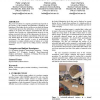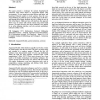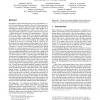1154 search results - page 78 / 231 » Intelligent virtual environments for virtual reality art |
AFRIGRAPH
2003
ACM
15 years 3 months ago
2003
ACM
The perceived realism of a computer generated image depends on the accuracy of the modeling and illumination calculations, the limitations of the display device, and the way in wh...
107
click to vote
GRAPHITE
2004
ACM
15 years 3 months ago
2004
ACM
This paper presents a technique for natural, fingertip-based interaction with virtual objects in Augmented Reality (AR) environments. We use image processing software and finger- ...
APGV
2004
ACM
15 years 1 months ago
2004
ACM
In virtual environments that use head-mounted displays (HMD), distance judgments to targets on the ground are compressed, at least when indicated through visually-directed walking...
VRST
2006
ACM
15 years 3 months ago
2006
ACM
This paper presents a study of the fine grain physiological responses of participants to an immersive virtual simulation of an urban environment. The analysis of differences in p...
APGV
2005
ACM
15 years 3 months ago
2005
ACM
The illusion of self-motion induced by moving visual stimuli (“vection”) has typically been attributed to low-level, bottom-up perceptual processes. Therefore, past research h...



